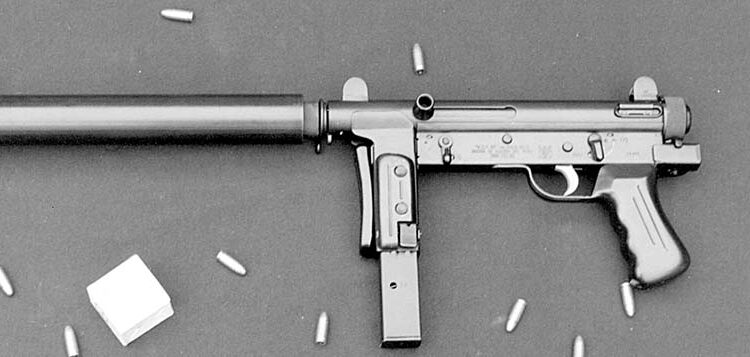By Ronaldo Olive
Part One of this three part series on Peruvian submachine guns is in SAR Volume 2 Number 3.
With the MGP-79 the Peruvians laid the first solid basis for the establishment of an indigenous small arms production capability. Not only had they designed a functional submachine gun, but also had it placed in series production and deployed with its forces, no small a feat for a nation with limited economic and industrial resources.
As time went by and operational use of their own SMG accumulated – pretty much as a result of Peru’s intensive anti-terrorist and anti-drug commitments – it was clear that there was ample room for improvement. The weapon was generally reliable, all right, but SIMA-CEFAR (the Navy’s organization in charge of small arms research, development, and manufacture) went ahead with analyzing criticism received from MGP-79 users, and, accordingly, incorporated changes into the basic design.
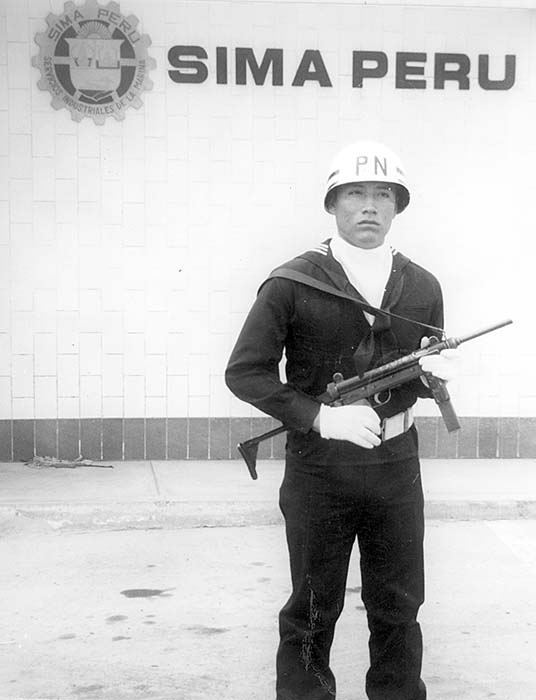
The resulting MGP-79A /MGP-87 series began to come out of the assembly line in 1987. Since this work involved both the modification of earlier “79s” and brand-new “87s”, some confusion (at least for the uninitiated…) resulted in terms of actual weapons’ designations. My examination of different examples has shown that some retain the original MGP-79 markings, others are marked MGP-79A, and some others display both MGP-79A and MGP-87, while others are marked MGP-87, only! In an effort to help in identifying the Peruvian subguns, regardless of the actual markings they may show, I’d suggest the following simplified system:
MGP-79 – original stockless model.
MGP-79A – foldable stock, same (240 mm-long) barrel.
MGP-87 – foldable stock, shorter (194 mm-long) barrel, either without or with a reduced-diameter perforated jacket.
Although the firing mechanism was left basically unmodified, noticeable external changes were made. The cocking handle, for example, was moved from the right to the left side, the bolt-locking notch being eliminated. In some earlier weapons, the actuator will be found turned into a vertical position, apparently to facilitate things for left-handed shooters. Very meaningfully, the ejection port was displaced from the top of the receiver to about 45 degrees to the right, thus eliminating that nasty tendency of having empty cartridges hitting your face.
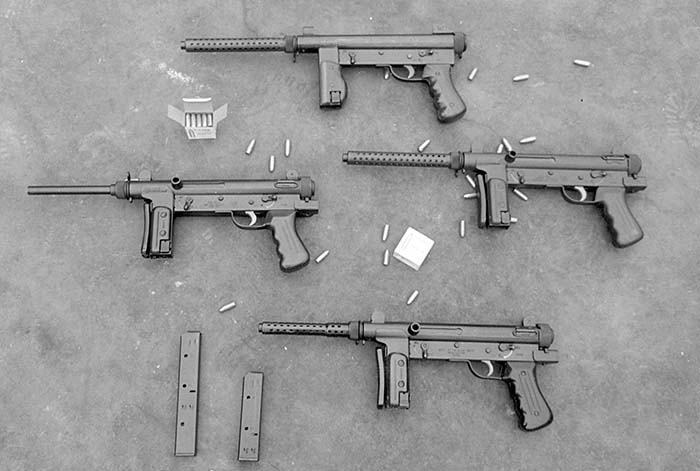
The sights retained the same radius, but the front unit became a post with sturdy steel protection ears, which were also incorporated for the U-notch (originally, a V-notch) rear sight. Other modifications in the receiver area included strengthening of the magazine housing structure and the change of the rear cap sling swivel into a fixed loop on the left side, just below the rear sight.
A most significant transformation was the addition of a foldable buttstock. The simple, stamped-steel structure folds very neatly to the right side of the lower receiver and in no way interferes with the weapon’s operation. The buttplate is so shaped as to come to a rest in a position around and flatly in front of the magazine housing. Therefore, the supporting hand can have a firm grip around it, should firing the subgun with the stock folded be required for any other serious reason than showing off for a new girlfriend
accompanying you to the range…
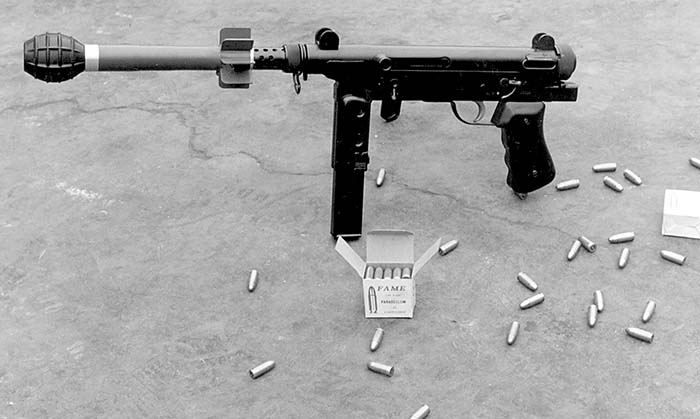
Some MGP-87s (in my observations, only those with the cocking handle turned upwards) feature a somewhat shorter stock, the differently shaped buttstock of which rests at the rear of the magazine housing, when folded. While still allowing the supporting hand to grasp around it, this arrangement is not so comfortable as the one found in most guns. When extended, it also leaves something to be desired in the ergonomics department, bringing the receiver (and, as a result, the rear sight) too close to one’s face.
Since the firing mechanism, in itself, was not changed, the new MGP79As and MGP-87s kept the same dual-lever system for applied safety and fire selection. Both switches are located on the left side of the lower body, the forward unit (operated with the thumb of the left/supporting hand), near the magazine housing, has the settings “F” (Fuego, or Fire), forward, and “S” (“Securo”, Safety) down. The rear one has the positions “RAF” (“Ráfaga”, Burst), down, and a most unusual “1×1” (semi-automatic), to the rear. There’s no doubt that unifying all those functions into a single lever would be much more practical from the user’s point of view, but it seems that redesigning the project accordingly would have taken too much effort, time, and money to justify such a change.
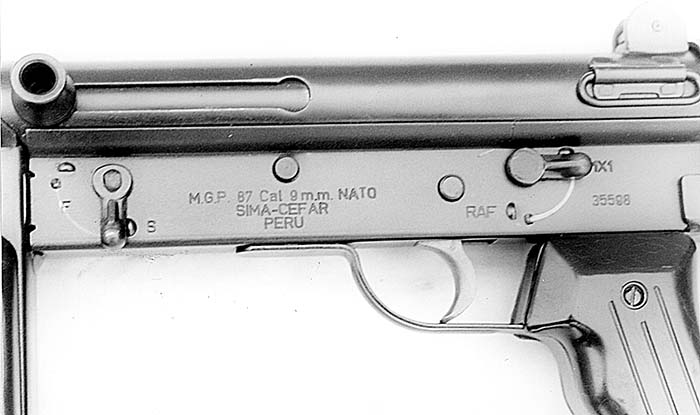
During an informal, but fully enjoyable, shooting session at the Callao Naval base, near the capital city of Lima, I could attest that the “new” MGPs are, indeed, much better than the original “79s”. The average cyclic rate of fire was maintained in the 700 rounds per minute range, which makes the 3.5 kg gun pretty much stable, even during long bursts. A decent trigger mechanism allows very short (2- or 3-round) bursts to be squeezed out, and single shots at full-auto setting are quickly mastered by any shooter with basic SMG skills.
Precision is greatly enhanced when one uses the weapon in the semi-auto mode, which most people tend to ignore as a major operational employment option for submachine guns, notwithstanding what Hollywood movies have been promoting for ages. Indeed, subguns are superb, specialized weapons to fill the gap between short-range gear (revolvers, semi-auto pistols, and shotguns) and rifles. In my view, they are more like semi-auto carbines with a full-auto option for occasional use rather than automatic weapons for eventual single-fire use.
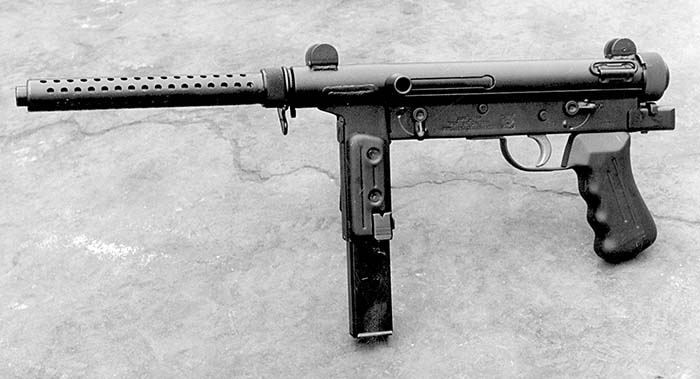
Every weapon represents a compromise of advantages and disadvantages, and the submachine gun is no exception. But one great asset it possesses is the capability of being effectively silenced, or suppressed, if you like. And the people from SIMA-CEFAR (renamed SIMA Electronica in 1996) have taken full advantage of this, offering a pretty good silencer for the “79A/87” series. It consists of a complete (integral with its own short
barrel) unit which is quickly installed by unscrewing and removing the original barrel, and subsequently screwing the suppressor into the receiver. Although no actual sound measurements were possible at the time, performance at the range was equivalent to the best around, always bearing in mind that the basic purpose of a sound suppressor is to “disguise” the noise signature of a firearm, not make it, eh, “silent”.
Most unusual for a buzzgun, the MGP-87 has a grenade-launching capability. The use of a smaller-diameter barrel jacket allows fragmentation grenades to be launched from the weapon, thus increasing versatility in combat. Although ranges are inferior (about 100 meters) to those achieved with rifle-launched grenades (300 or so meters), it is still about three times farther than one can hand-throw a grenade.
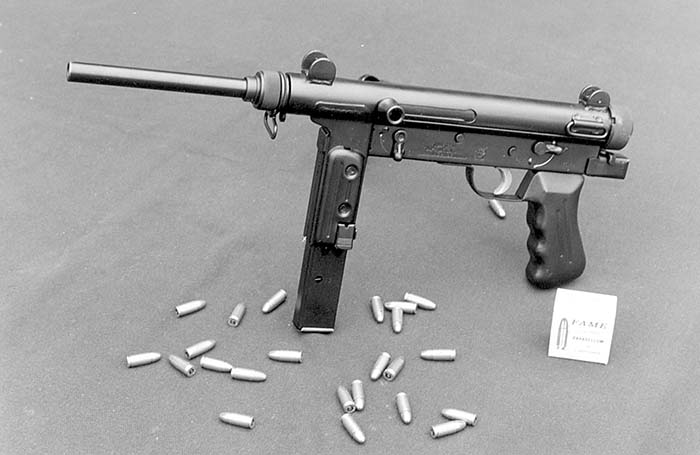
Evolution of the Peruvian-made submachine guns from the pioneer MGP-79 through the intermediate MGP-79A to the later MGP-87 (which remains in production) not only made the country self-sufficient in terms of this class of police/military weapon, but also allowed it to gain priceless experience to create a newer, state-of-the-art SMG, the MGP-84 Mini.
Don’t miss Part 3 of the Peruvian Submachine Gun series is in the next issue of SAR!
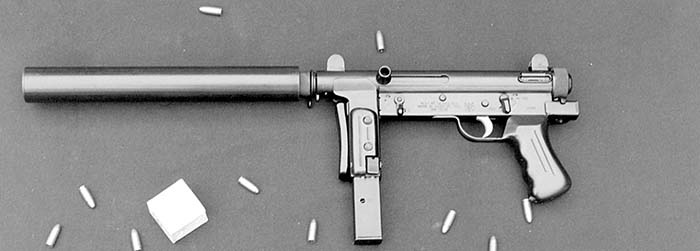
MGP-87 Technical Specifications
Cartridge: 9 x 19 mm
Operation: Blowback, selective fire
Feed: 20- or 32-round detachable box magazine
Weight: no magazine: 2.9 kg, full 32-rd magazine: 3.5 kg
Length: stock extended: 766 mm, stock folded: 500 mmBarrel: 194 mm
Cyclic rate: 700 rounds/min
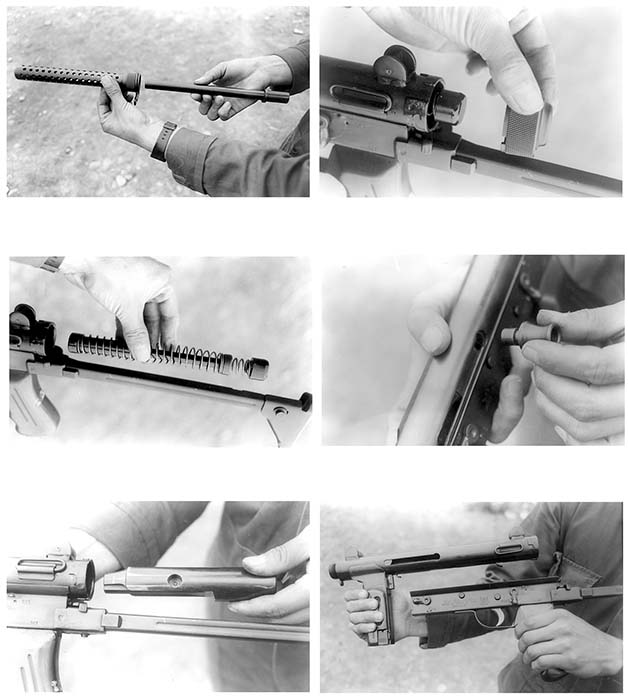
| This article first appeared in Small Arms Review V2N4 (January 1999) |



